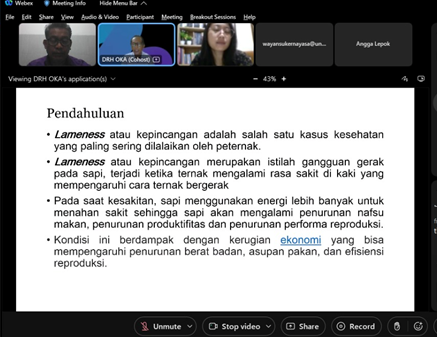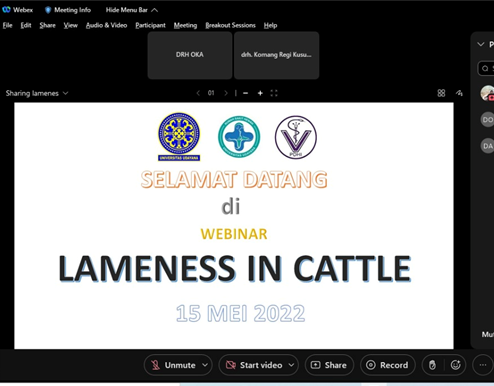Veterinary Teaching Hospital FVM Udayana University and IVMA Bali Held Veterinary Continuing Education: Lameness in Cattle
The COVID-19 pandemic is forcing people to reduce direct interactions between individuals and groups, and limiting people's movements in an effort to reduce the spread of the virus. But that doesn't stop us from sharing knowledge. This condition is also used by the Veterinary Teaching Hospital (VTH) of the Faculty of Veterinary Medicine (FVM) of Udayana University and the Indonesian Veterinary Medical Association (IVMA) Bali to increase veterinary medical knowledge in Bali and share knowledge / knowledge sharing at sustainable Veterinary education events in Bali. lameness thing on cows which was held on Sunday, May 15, 2022.
This continuing education event was attended by Large Animal Veterinary Practitioners and students of the Faculty of Veterinary Medicine Udayana University. In this webinar the speaker was Drh Nyoman Oka Widiarta M.Si. from the Department of Agriculture and Food of Badung Regency. The continuing education event organized and coordinated by VTH Udayana and IVMA Bali was opened with remarks by the Director of VTH Udayana, Prof. Dr. drh. I Ketut Puja, M.Kes. In his opening remarks, Prof. Puja said that the condition of our livestock in Bali is currently threatened with foot and mouth disease. This coincided with the FMD outbreak in Java. Therefore, the topic that we raise at this continuing education event is very appropriate, considering that lameness is one of the symptoms of Foot and Mouth Disease (FMD). This online webinar discusses inequalities in cattle farming at both the herd and individual levels. Therefore, veterinarians should be familiar with this lame state. For this reason, it is very important that veterinarians have a good understanding of these circumstances. Prof. Puja hopes that through this continuing education webinar, it is hoped that participants will gain knowledge about how to recognize and treat appropriately when a cow is found to be lame. This continuing education is also intended to make veterinarians more confident in observing and treating lameness.

In his presentation, Drh Oka said that foot problems are a major health problem for many cattle farmers. Cow lameness causes poor performance and large economic losses. Nutrition and feed, housing and environment, concomitant diseases, genetic influences, and management factors all predispose cattle to this problem. The largest incidence of lameness involves the legs, and among them, the hind legs. The most common causes of lameness are: laminitis, digital dermatitis, and foot rot. Since each cow often has more than one cause of lameness at a time, it is important to understand the different types of lameness and their treatment and prevention protocols.
In particular, Drh Oka said that FMD should be our concern, considering that Bali cattle are the only assets of our cattle. When we see there is a lameness, we have to think about FMD. This is a form of our vigilance against FMD cases. At the end of his presentation, Doctor Oka said that the success of lame therapy depends on the speed of detection of lameness.





